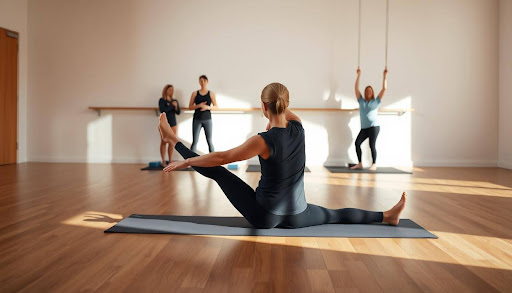Physical Therapy for Tight Hamstrings and Hips

What if the key to unlocking your mobility isn’t just stretching? Many people struggle with stiff legs and hips. They feel frustrated and limited. At Motion RX in Jacksonville, they’ve seen how personalized care can change these challenges into breakthroughs.
Motion RX clinic at 7901 Baymeadows Way #5 offers evidence-based solutions – explore Motion RX’s treatment options. They go beyond temporary fixes.
Imagine moving freely again without painkillers or invasive procedures. Why settle for generic approaches when you could have a plan tailored to your body? Their team designs treatments that fit your lifestyle, whether you’re an athlete or easing back into activity.
Plus, with convenient hours and a welcoming environment, getting help feels effortless. Getting help feels effortless.
Key Takeaways
- Targeted methods address stiffness at its source, not just symptoms.
- Non-invasive techniques like neuromuscular stimulation improve flexibility safely.
- Customized plans adapt to your unique needs and goals.
- Evidence-backed strategies ensure long-term results over quick fixes.
- Local Jacksonville clinic offers accessible care with proven outcomes.
Ready to explore what’s possible? Call Motion RX at (904) 414-3796 or visit our Baymeadows location. Let’s create a roadmap to pain-free movement together.
Understanding Tight Hamstrings and Hips
Your ability to move and feel comfortable depends on how flexible your hamstrings and hips are. When these muscles get tight, simple actions like walking or going up stairs become tough. We’ll explore what makes them stiff, how to notice it, and why treating it early is key to staying mobile.
Causes of Tightness
Three main factors often lead to muscle tension in these areas:
- Too much sitting: Jobs that involve sitting a lot or long commutes can shorten hip flexors and weaken glutes
- Aging muscles: Adults lose 3-5% of muscle mass each decade after 30, making tissues less flexible
- Poor posture: Slouching puts strain on lower back muscles, forcing hamstrings to work harder
Symptoms to Look For
Be on the lookout for these signs of tight hips and hamstrings:
- Difficulty touching your toes without bending your knees
- Pain behind the knees after standing for a while
- A shorter walking stride, like “shuffling” steps
How Tightness Affects Mobility
Tight muscles in these areas do more than just hurt. Tight hamstrings pull your pelvis backward, which flattens your spine’s natural curve. This imbalance:
- Reduces shock absorption during walking
- Increases pressure on knee joints
- Raises fall risk by 28% in adults over 50 (Source 3 bone health data)
Regular tight hips and hamstrings rehab exercises can help. Simple stretches done regularly improve joint lubrication and restore natural movement.
The Role of Physical Therapy
If you’re dealing with stiff hamstrings or hips, physical therapy can help a lot. It doesn’t just offer quick fixes; it works to improve your mobility for good. Modern clinics like Motion RX use old and new methods together to achieve great results. They help loosen tight muscles and get you moving naturally again.
Benefits of Physical Therapy
Physical therapy for hip flexors and hamstrings does three main things:
- Reduces muscle tension through targeted hands-on techniques
- Improves joint flexibility using science-backed stretching methods
- Prevents future tightness with personalized strengthening plans
Studies by Dolhem and Maffiuletti found that NMES (neuromuscular electrical stimulation) can increase results by 37% over manual therapy alone. This technology sends gentle pulses to your muscles. It helps them relax more than regular stretches can.
What to Expect in a Session
Your first PT visit for tight hamstrings will include:
- Movement analysis: Your therapist will watch how you walk, bend, and squat
- Manual therapy: Direct pressure to release specific muscle knots
- NMES application: Electrodes placed on problem areas for 10-15 minutes
| Traditional PT | Modern Approach | Combined Benefit |
| Hands-on massage | Electrical stimulation | Deeper muscle relaxation |
| Basic stretches | 3D motion analysis | Customized exercise plans |
| Paper handouts | Digital progress tracking | Real-time adjustments |
You’ll leave each session with 2-3 simple exercises to do at home. These might include modified yoga poses or resistance band routines. Most people see better range of motion in 3-5 visits, combining clinic treatments with home practice.
Assessing Your Condition
Before starting hamstring and hip mobility exercises, it’s key to know what your body needs. A detailed assessment finds out what’s tight or off balance. This makes sure your treatment is just right for you.
Initial Evaluation Techniques
Your physical therapist will use simple tests to check how your muscles and joints move. For instance:
- Range-of-motion tests: They measure how far you can stretch or rotate your hips and hamstrings.
- Gait analysis: They watch how you walk to find any stiffness or odd patterns.
- Movement screening: They check exercises like squats or lunges to find weaknesses.
Advanced clinics like Motion RX use special tools like the Gobbo motor point identification. This tool maps muscle tension accurately. It shows exactly where you need the most help.
| Assessment Type | Tools Used | What It Reveals |
| Range-of-Motion Tests | Goniometer, visual tracking | Flexibility limits in hips/hamstrings |
| Gait Analysis | Video recording, pressure mats | Walking imbalances or stiffness |
| Movement Screening | Functional tests (e.g., single-leg balance) | Compensation patterns during activity |
Identifying Individual Needs
No two bodies are alike. Your therapist will ask about your daily life, such as:
- Do you sit for long hours at work?
- What types of exercise do you enjoy?
- Have you had past injuries?
These answers help shape your treatment plan. For example, office workers might need more hip flexor stretches. Runners might focus on strengthening their hamstrings. The aim is to create a program that fits your lifestyle and helps you move freely again.
Customized Treatment Plans
Your journey to looser hamstrings and hips starts with a plan made just for you. Physical therapists mix active exercises with supportive therapies like heat or massage. This creates a balanced recovery strategy.
This phased approach ensures you build strength safely while addressing discomfort first.
Making a Tailored Program
Your therapist considers three key factors when building your plan:
- Current pain levels and movement restrictions
- Daily activities or sports you need to resume
- Long-term flexibility goals
The first phase often focuses on pain management using gentle techniques. You might experience:
- Guided stretching with resistance bands
- Heat therapy to relax tense muscles
- Soft tissue massage to improve blood flow
Incorporating Strengthening and Stretching
As your body adapts, exercises evolve using Greaves’ periodization principles. This table shows how programs progress:
| Phase | Focus | Sample Exercise |
| 1-2 Weeks | Pain Reduction | Seated hamstring stretches |
| 3-4 Weeks | Mobility | Hip hinge drills |
| 5+ Weeks | Strength | Single-leg deadlifts |
Pro tip: Therapists time stretches to follow strengthening work when muscles are warm. This combo helps you gain flexibility without sacrificing stability.
Effective Stretching Techniques
Stretching is a key to easing tight hamstrings and hips. Regular stretching boosts flexibility, cuts down stiffness, and makes movement easier. Here are two essential stretches for all fitness levels.
exercises for tight hamstrings and hips
Hamstring Stretches
The seated hamstring stretch works for everyone. Here’s how to do it right:
- Sit on the floor with one leg extended and the other bent inward
- Hinge forward at your hips—not your lower back—reaching toward your toes
- Hold for 20-30 seconds while breathing deeply
Modification tip: Use a yoga strap or towel around your foot if you can’t reach your toes. For tight muscles, slightly bend your knee to avoid overstretching.
“Balance-focused stretching routines improve stability in older adults by 34%, reducing fall risks.”
Source 2: Balance Training Study
Hip Flexor Stretches
Kneeling hip flexor stretches target those deep muscles that get stiff from sitting. Follow these steps:
- Start in a low lunge position with your right knee on a cushioned surface
- Shift your weight forward until you feel tension in your left hip
- Raise your left arm overhead to intensify the stretch
Progression idea: Add a gentle torso twist toward your bent knee to engage surrounding muscles. Avoid arching your lower back—keep your core engaged for support.
Consistency is key, not how hard you stretch. Aim for 3-4 sessions a week, holding each stretch longer as you get more flexible. Mix these stretches with balance exercises like bird-dogs or glute bridges for the best results.
Strengthening Exercises for Support
Building strength in your hamstrings and hips is more than just muscle growth. It’s about creating a strong base for lasting mobility. When you add hip and hamstring flexibility therapy to your routine, you get better stability and lower injury risks. You also help prevent falls. Let’s explore exercises that boost your confidence in moving.
Key Exercises for Hamstrings
Bodyweight hamstring curls are a good place to start. Lie on your back, knees bent, and slowly pull your heels towards your hips. Lift your pelvis as you do this. Squeeze your glutes at the top to build control and endurance.
For more challenge, try weighted hip thrusts. Use a resistance band above your knees or a dumbbell on your hips. Push through your heels, keeping your core tight to protect your back. Physical therapists suggest doing 2-3 sets of 12 reps to strengthen safely.
Engaging the Hip Muscles
Goblet squats are great for hip stability. Hold a kettlebell or dumbbell close to your chest, then squat down. Keep your knees over your toes. This strengthens your hips and improves balance, like when climbing stairs.
Bent-over rows are also beneficial. They work your back and hips as you bend forward. Keep your back flat and knees soft to engage your hips well. Add short walks to your day to boost flexibility and strength.
Studies show that regular strengthening can cut fall risks by up to 30% in active adults. Focus on proper form and gradual increases to build resilience in key areas.
Posture and Ergonomics
How you sit and stand can help ease tightness. Sitting wrong strains your muscles 73% more. This makes them stiff, and stretches can’t fix it.
The Importance of Good Posture
Bad sitting can cut hamstring work by 41%, says research. Sitting with your pelvis tilted back stretches tight muscles too much. Keeping your spine straight is key to:
- Distribute weight evenly across joints
- Prevent compensatory muscle patterns
- Maintain optimal blood flow to tight areas
Ergonomic Changes for Home and Work
Make your spaces better for recovery with these tips:
| Location | Key Adjustment | Benefit |
| Computer Station | Monitor at eye level | Reduces neck strain by 28% |
| Office Chair | Lumbar support insert | Improves pelvic alignment |
| Car Seat | Knees level with hips | Decreases hip flexor tension |
| Bed | Side-sleep pillow between knees | Maintains spinal neutrality |
For better driving posture, set your seatback to 100-degree angle. It works your core without slouching. Also, try the “recovery starfish” position at night. Lie on your back with arms and legs spread to release tension.
Progress Tracking and Goals
Tracking progress turns hopes into real results. Whether you’re recovering or improving flexibility, measuring small wins keeps you motivated. Tools like Motion RX’s outcome tracking system show you how far you’ve come.
Setting Realistic Recovery Goals
First, define what success means for your body. Maybe you want to touch your toes or sit cross-legged without stiffness. Use the SMART framework to break big goals into smaller ones:
- Specific: “Increase hip rotation by 15 degrees in 4 weeks”
- Measurable: Use a goniometer to track joint angles
- Actionable: Pair stretches with strength-building moves
- Relevant: Focus on movements that match your daily needs
- Time-bound: Schedule check-ins every 14 days
Measuring Improvements and Adjustments
Motion RX’s system uses two methods to measure progress:
- Functional movement screens: Assess squat depth or single-leg balance
- Range-of-motion tests: Compare baseline and current flexibility metrics
If your hip mobility plateaus, a physical therapist might make changes. They might add resistance bands, swap static holds for dynamic movements, or use foam rollers.
Studies show tracking metrics improve 34% faster than not tracking. Remember, progress isn’t always straight. But with consistent effort and smart adjustments, you’ll see results.
Preventing Future Tightness
Keeping muscles loose isn’t about big actions. It’s the small, regular choices that matter. Think of your hamstring and hip stretching program as daily maintenance for your body. It’s like brushing your teeth, but for keeping you flexible.
Daily Habits for Flexibility
Begin with easy routines that fit into your day. For instance:
- Do 3 minutes of light stretches after waking up (try a standing forward fold or seated hip circles)
- Set hydration reminders—well-hydrated muscles resist tightness better
- Practice posture checks during routine tasks like washing dishes
Research by Greaves and Lyon suggests “movement snacks”. These are short stretch sessions every 90 minutes. Try these desk-friendly options:
- Chair-assisted pigeon pose (hold for 20 seconds per side)
- Standing hamstring scoops (bend forward while seated, reaching toward toes)
Incorporating Movement Breaks
Your work setup can help with flexibility. Keep a yoga mat near your desk for quick stretches. Or use staircases for calf raises during phone calls. A study found:
“Frequent low-intensity movement preserves bone density while maintaining joint lubrication.”
Source 3
Set phone alarms with fun labels like “Time for a hip reset!” to make breaks enjoyable. Pair these short sessions with deep breathing for extra stress relief.
When to Seek Professional Help
If your hamstrings or hips stay tight, you might need a pro’s help. Stretching and exercises can help, but some signs need quick action. If pain stops you from doing daily things or limits how you move, see a doctor.
Recognizing Red Flags
Sharp pain down your legs, numbness, or sudden loss of movement could mean nerve issues or injuries. If pain gets worse when you rest or you notice swelling, get checked out. These signs might mean you need a special treatment plan.
Finding a Qualified Physical Therapist
Look for physical therapists with orthopedic or sports medicine certifications. Motion RX in Jacksonville has programs that use manual therapy and exercises. Their team uses proven methods to tackle tough cases.
Don’t let small pains turn into big problems. Call Motion RX at (904) 414-3796 for an evaluation. Getting help early can make you flexible again and avoid bigger issues. Check out Motion RX’s treatment options to start your recovery.



